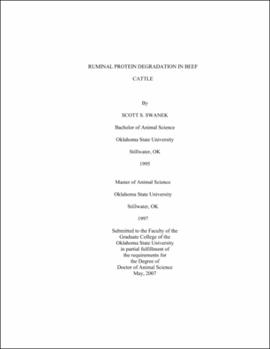| dc.contributor.advisor | Krehbiel, Clinton R. | |
| dc.contributor.author | Swanek, Scott S. | |
| dc.date.accessioned | 2013-11-26T08:22:40Z | |
| dc.date.available | 2013-11-26T08:22:40Z | |
| dc.date.issued | 2007-05 | |
| dc.identifier.uri | https://hdl.handle.net/11244/6627 | |
| dc.description.abstract | Scope and Method of Study: In Exp. 1, five ruminally cannulated steers were used in a 5 x 5 Latin square design experiment to determine the effects of increasing urea level on intake, nutrient digestion, nitrogen balance and ruminal kinetics. Isocaloric and isonitrogenous steam-flaked corn diets with urea concentrations of 0.0, 0.8, 1.2, 1.6, or 2.0% (DM basis) were offered ad libitum to steers. Total urine and feces, and ruminal fluid were collected. In Exp. 2, nine ruminally-cannulated steers were used in a 6 X 6 Latin square design experiment to evaluate three roughage: concentrate (70:30, 40:60, and 10:90) ratios with or without monensin on the extent and rate of in situ ruminal degradation of soybean hulls (SH), wheat middlings (WM), dried distillers grains with solubles (DDG), cotton seed meal (CSM), soybean meal (SBM), and porcine blood meal (BM), and on ruminal kinetics. | |
| dc.description.abstract | Findings and Conclusions: In Exp. 1, dietary urea level did not affect (P>0.10) DM intake. Urea level did not affect (P>0.10) fecal output of OM and starch, or OM, N, or starch digestibility. Urea concentration did not affect (P>0.10) total N balance, N balance as a percent of N intake, or liquid dilution rate and pH. Our data suggests that urea levels up to 2% of diet DM can be used in steam-flaked corn finishing diets without altering intake, nutrient digestion, or ruminal kinetics. In Exp. 2, monensin had no affect (P>0.10) on DM, OM, NDF or starch intake, output or digestibility, or total VFA concentration. Monensin decreased (P<0.01) the N and DM B fraction of in situ ruminal degradation and the rate of N and DM degradation, and increased the C fraction of N and DM. Ruminal protein degradation was decreased by 6.7% (P<0.01) for monensin supplementation, suggesting monensin has a protein sparing effect. Dry matter and OM intake, starch digestibility and molar proportions of individual VFA did not differ among roughage: concentrate ratios. Fecal OM and NDF output decreased (P<0.01), and digestibility and total VFA concentration increased (P<0.01) with increasing level of concentrate. As level of concentrate increased, the B fraction and the rate of degradation decreased and the C fraction increased, resulting in decreased DM and N ruminal degradation (P<0.01). All of the byproducts responded similarly except blood meal, which remained relatively constant across treatments. Because dietary factors affect in situ degradation, in situ incubations should be conducted in rumens of animals that are consuming the diet of interest. | |
| dc.format | application/pdf | |
| dc.language | en_US | |
| dc.rights | Copyright is held by the author who has granted the Oklahoma State University Library the non-exclusive right to share this material in its institutional repository. Contact Digital Library Services at lib-dls@okstate.edu or 405-744-9161 for the permission policy on the use, reproduction or distribution of this material. | |
| dc.title | Ruminal protein degradation in beef cattle | |
| dc.contributor.committeeMember | Horn, Gerald W. | |
| dc.contributor.committeeMember | Purvis, Hebbie T. | |
| dc.contributor.committeeMember | Goad, Carla L. | |
| osu.filename | Swanek_okstate_0664D_2296.pdf | |
| osu.accesstype | Open Access | |
| dc.type.genre | Dissertation | |
| dc.type.material | Text | |
| thesis.degree.discipline | Animal Nutrition | |
| thesis.degree.grantor | Oklahoma State University | |
